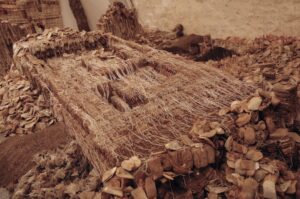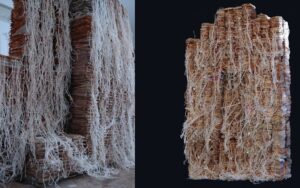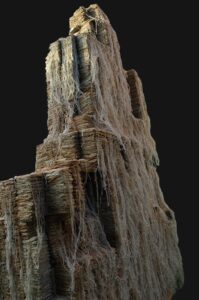It is no longer just a question of the tea that we drink, that we taste and that we smell, but of intimately organized spaces that balance each other, of colors formed by and for the other senses. Through the contact of each particular breath with the liquid element in which the teabag bathes, this thousand-year-old beverage is transformed into a type of amniotic magma where the bag is reborn, unique and singular… It will henceforth be cared for and dried to access a state of redemption. The bag acquires humanity whose presence prefigures the sensitive and infinite nature of beings and things
Always the same and always different, a trace of experience and a loan of oneself. Together and separately in a monochromatic polyphony, miniscule and infinite come together consecrating the surface of the canvas as a place where what may be sensed and what may be understood by the intellect merge.
Using the same laconic and precise movements, inescapably repeated, placed one beside the other, with and despite the others, like our most intimate daily acts, Rotch experiences time, moving forward to the rhythm of its inner temporality, apart from any circumstantial chronology. Reflecting a sensation rather than a consciousness of time, a depth rather than an experience of duration, the question here is not one of mastering the « temporal protocols » but of being impregnated with hosts of instants in mutation, faded traces of a past without memory. The apprehension of absolute time, the perception of the fragility and finitude of the ego faced with the incommensurable space of infinite time, is only possible to the extent that experience and knowledge are in harmony with our intuitive and sensorial faculties. Taking the time to probe the depths that may be sensed of the image as a fragile and tempered space of intimacy, allowing it to cross our senses, allowing us to cross it. Seeking its own imponderables, vacillating in the time and space of each sequence, composing with more or less fleeting traces, moving forward, building in order to be rebuilt.
The apprehension of absolute time, the perception of the fragility and finitude of the ego faced with the incommensurable space of infinite time, is only possible to the extent that experience and knowledge are in harmony with our intuitive and sensorial faculties. Taking the time to probe the depths that may be sensed of the image as a fragile and tempered space of intimacy, allowing it to cross our senses, allowing us to cross it. Seeking its own imponderables, vacillating in the time and space of each sequence, composing with more or less fleeting traces, moving forward, building in order to be rebuilt.
Gilda R. Guégamian, September 2006




